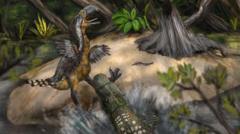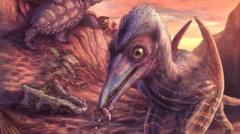Researchers have recently uncovered compelling evidence indicating that a "terror bird," a formidable avian predator from 13 million years ago, likely met its demise at the jaws of an even larger carnivore—a caiman. This revelation stems from meticulous examinations of fossilized leg bones by a team of palaeontologists in Colombia, reinforcing the complex interplay of life among extinct species.
Terror birds, exceeding human height with formidable beaks and legs adapted for hunting, once dominated prehistoric landscapes. The analysis, featured in the journal Biology Letters, revealed distinct teeth impressions on a fossil discovered in the Tatacoa Desert, a region known for its rich paleontological history. The research team employed 3D digital scanning techniques to illustrate a dramatic altercation, ultimately concluding that the terror bird did not survive this fierce confrontation.
The leg bone in question, unearthed more than a decade ago, was identified as that of an extinct terror bird measuring approximately 2.5 meters tall. Palaeontologists speculate that this bird utilized its powerful legs and beak to tackle prey in a swampy environment, which characterized the area during the Middle Miocene epoch. Lead researcher Dr. Andres Link from the Universidad de Los Andes remarked, “There is no sign of healing in the bite marks on the bone,” leading to the hypothesis that the bird likely perished from the attack.
Fossils from the Tatacoa Desert, which once featured humid swamps rich in diverse species, have provided a wealth of knowledge regarding ancient ecosystems. The bone's initial discovery in the 2000s by fossil collector César Augusto Perdomo piqued the interest of researchers who recognized its significance. Examination of the bite marks suggested that the predator behind the attack was a species of caiman, possibly the Purussaurus neivensis, a formidable crocodilian reaching lengths of up to five meters.
Dr. Link describes the ambush tactics employed by these ancient reptiles, reminiscent of modern crocodiles waiting patiently for unsuspecting prey. The findings not only shed light on the interactions between apex predators but also reveal the vulnerability of terror birds, previously thought invulnerable. The research highlights how fossilized remnants can provide vital clues about the interplay of species in ancient ecosystems and their adaptive strategies.
In conclusion, this fascinating study underscores the importance of paleontological research in piecing together the historical narratives of life on Earth and enriching our understanding of extinct species, their environments, and their interrelations. As Dr. Link aptly noted, "Every piece of a body helps us to understand so much about life on the planet in the past."

















